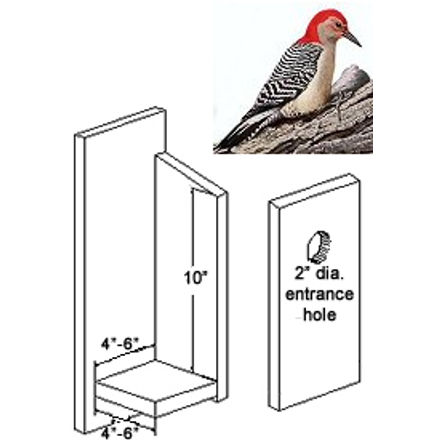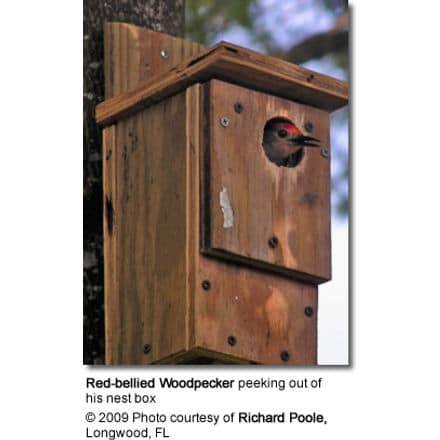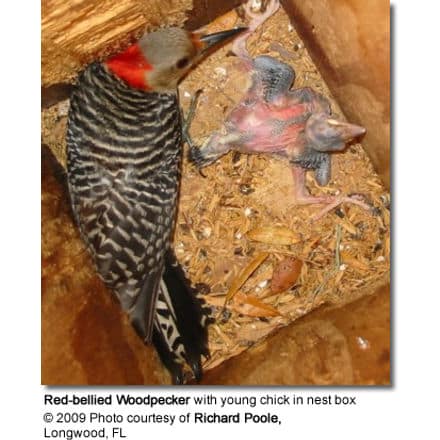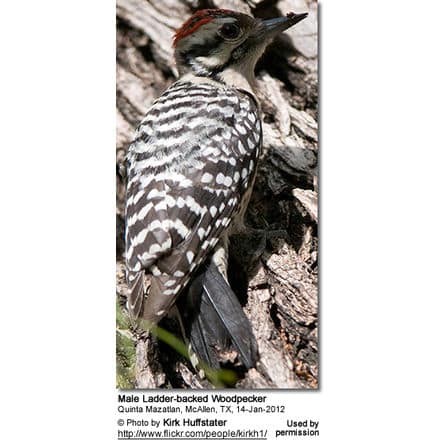Nesting Box Woodworking Plan: Red-bellied Woodpeckers
Nesting Box Woodworking Plan: Red-bellied Woodpeckers
Red-bellied Woodpeckers use this nest box. Lewis’s Woodpeckers, Northern Flickers, and Owls may use this box.
The nest box for the Red-bellied Woodpecker is constructed with Red Cedar. Wood stock is rough-cut on both sides so birds can grip interior and exterior surfaces.
When constructing the box it may be recommended to create one or two ventilation openings in the floor and under the roof to improve ventilation inside the box to protect the eggs and nestlings from overheating on hot summer days. Although some experts disagree with the notion that ventilation openings are needed at all. Please refer to this article for further information. This may also depend on location of nest box, exposure to direct sun as well as material used to build the nest box.
A hinged roof facilitates easy access for monitoring and cleaning. Assemble the box with corrosion resistant screws. Red-bellied Woodpecker seem to prefer circular to rectangular entrances.
Fill the box to the top with wood shavings or animal bedding purchased at the pet store. Please note that fine sawdust is not recommended as it remains damp, can become moldy and is difficult for the birds to work with. Packing the nestbox with wood shavings / chips will also discourage starlings and sparrows from nesting in the box, and the process of excavating the nestbox (or any cavity) is a natural part of a woodpecker’s mating behavior.
Mount on a post or a tree, along a woodland edge or at a clearing. Line the nest box with a bed of wood chips.
Remove the nest box in late summer or fall after the brood rearing seasons are over. Clean thoroughly and repair for the next season.
RED-BELLIED WOODPECKERS (“RBWO”) AND NEST BOXES
Below article courtesy of
Richard Poole and Christine Brown
Longwood, FL 32779
T
The depth of natural cavities constructed by RBWOs is 10-12 inches. We have been monitoring nests boxes ranging from 4 x 4 x 10 (W x D x H) to 8 x 8 x 16 for several years and found that RBWOs prefer smaller nest boxes. In several instances larger boxes were in the same yard as the small boxes chosen by RBWOs.
While observing nest boxes, we learned that RBWOs destroy not only insects. In a friend’s back yard we had placed four boxes, two 5.5 x 3.5 x 12″ and two 5.5 x 5.5 x 14″ each with a 2″ hole. An Eastern Screech Owl nested in one large box and a Tufted Titmouse hatched young in the other large box. We were concerned that the owl might make a meal of the titmice, as it would have no trouble getting into the titmouse box. But the owls caused no problem.
One day as Christine was visiting our friend; they observed two young titmice leaving the box. The young birds were capable of weak flight. Then a male RBWO emerged from the box. The woodpecker returned repeatedly to the box, calling and removing feathers form the box. It also visited the box with the owl and tapped near the entrance hole, but did not enter. A few days later Richard climbed a ladder to clean the box inhabited by the titmice. Two young dead titmice were found at the bottom of the box, predated by the RBWO.
Next year a RBWO nested in the 3.3 x 5.5 box and the owl was back in its large box. The titmice did not return.
On the lighter side, a few years ago we spent Christmas at my son’s house. I opened my present and looked inside. “Eric, why are you giving me a nest box, I’ve made hundreds,” I exclaimed. His reply, “Look again, Dad.”
I did and the box had a cable attached. Inside was a small TV camera. When we returned home, I installed the box a few feet from our house, and a RBWO nested inside. After the eggs hatched a friend would visit us and sit for as long as an hour watching the TV feed as the parents fed the babies in a box 4 x 4 x12 inches. “Better than TV,” was his comment. We now have a DVD of the complete process, from eggs to the last day of the young RBWOs in the box.
Results from our observations plus the fact that RBWO natural cavities are not 7.5 x 9.5 x 17 inches suggests that the commercial nest boxes are much larger than boxes preferred by RBWOs. Think small.
Safety First when construction a nest box
- Assemble woodworking projects in a safe, protected area.
- Always wear eye protection. Eye injuries are the most common accidents.
- Keep hardware and tools away from children and pets.
- Store your tools and hardware neatly away after use.
Please Note: The articles or images on this page are the sole property of the authors or photographers. Please contact them directly with respect to any copyright or licensing questions. Thank you.







